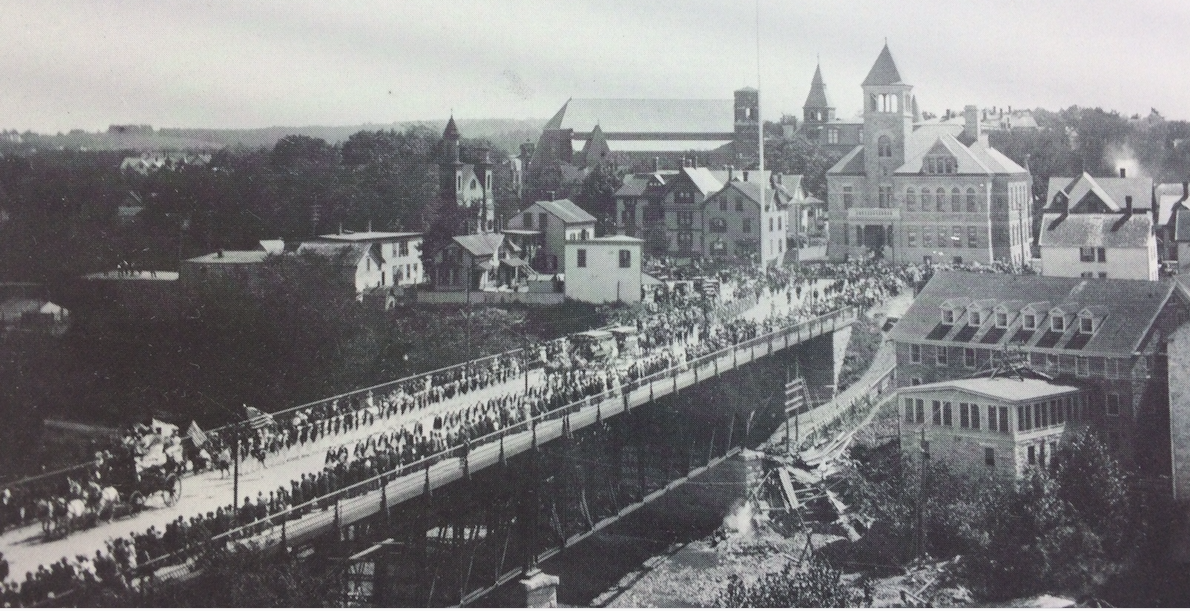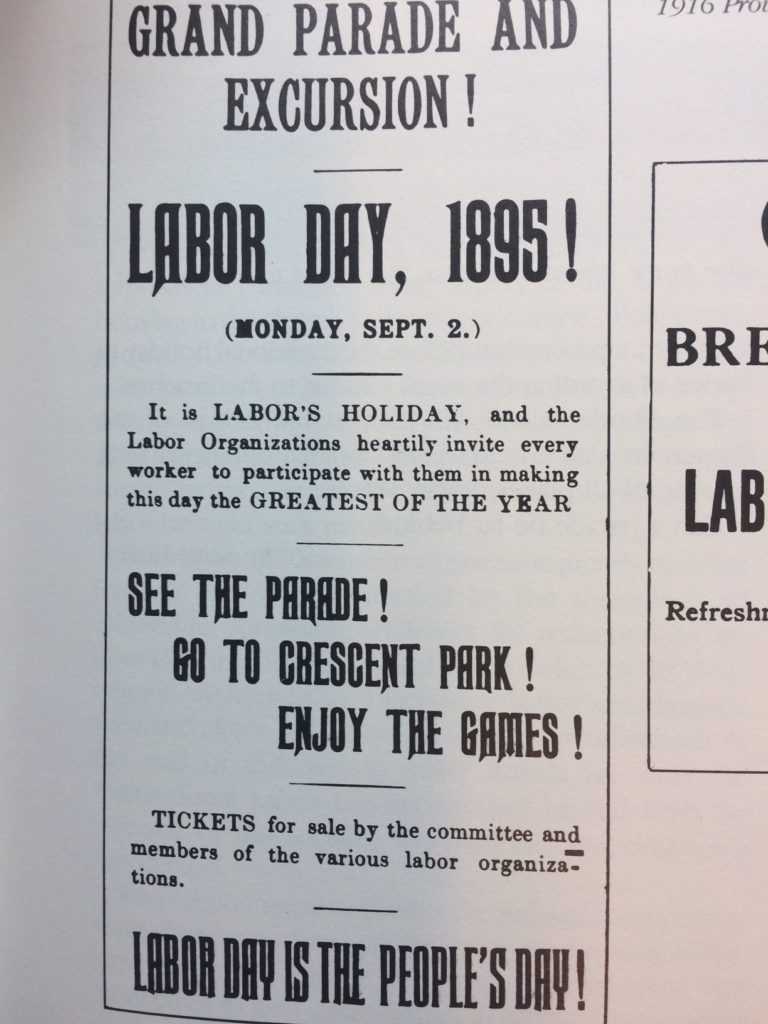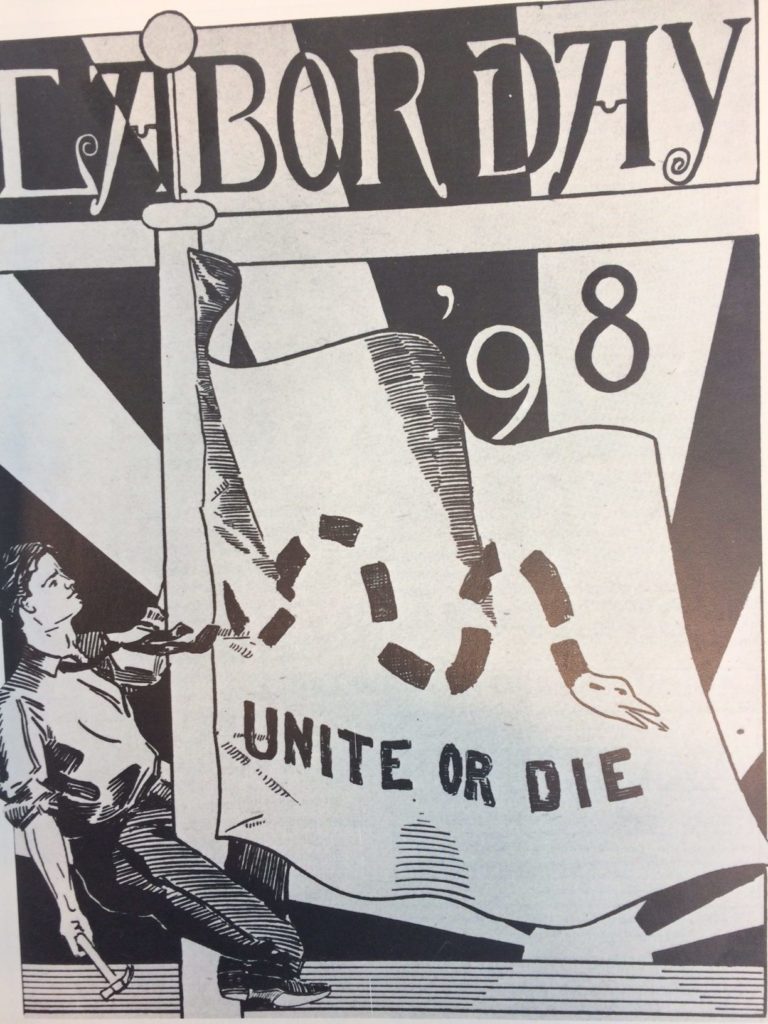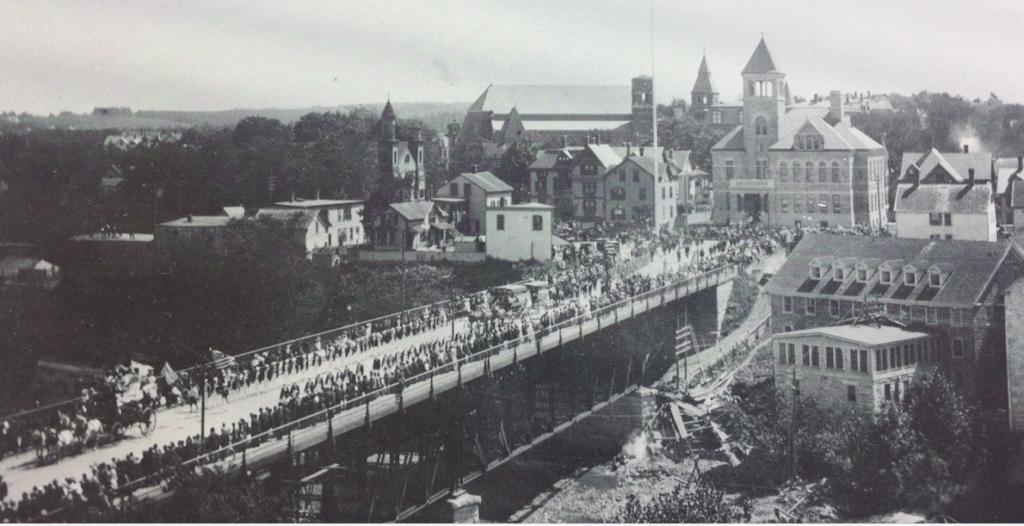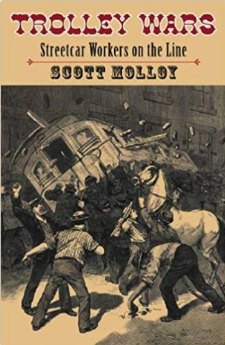Two thousand workers marched in to history 125 years ago when they participated in the state’s first Labor Day parade in 1893 in Providence, while a crowd of ten thousand watched and eventually made their way to Rocky Point. In the midst of the financial panic of 1893 Rhode Island workers secured a long-sought ambition—the establishment of the first Monday in September as a legal holiday.
The state’s horny-fisted sons and daughters of toil had marched, petitioned, and agitated for over a decade. Rhode Island workers witnessed New York and Oregon pass holiday legislation in 1887 and by the spring of 1893 most other states had followed suit. The General Assembly, under the prodding of elected representatives from various mill towns, finally joined the bandwagon. Governor Russell Brown signed the authorization.
Monday, September 4, 1893 was a beautiful day by all, accounts. Tens of thousands of Rhode Islanders walked or took a horsecar or electric trolley to the capital city. Three thousand union members lined up in divisions behind the Caledonia Fife and Drum Band, the 12-piece Olneyville Cadet Corps, L’Harmonie Canadienne Band and several other musical groups. Both the cigarmakers and the horseshoers fielded floats. The cigarmakers contrasted the favorable conditions in a union shop against the unregulated toil in a tenement sweatshop in a vivid display.
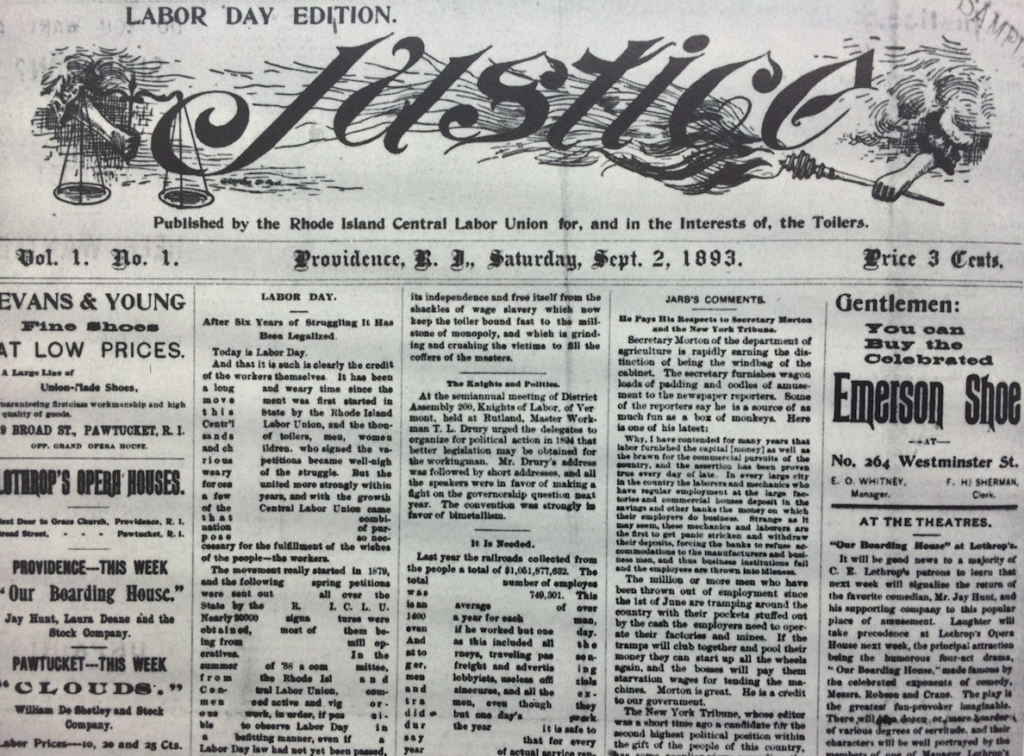
The Rhode Island Central Labor Union (AFL) celebrated the official establishment of Labor Day as a state holiday in 1893 with this special edition of Justice.
The Rhode Island Central Labor Union, predecessor to the state AFL-CIO today, sponsored the parade. Eighteen skilled unions participated including the Carpenters Local 94, Painters and Decorators Number 195, and Providence Typographical Union Local 33. Those three unions still exist a century later. Other organizations like the Cornice Workers, Mule Spinners and Pavers and Pounders Union have long since affiliated with other labor groups as technology altered jobs over the years. Many participating unions that day carried sparkling new banners; the printers wore fancy badges that cost eight cents each; and the Plasterers donned white hats, aprons and canes.
The march began at 9:30 and “put all previous civic processions in the shade.” Starting from Market Square, the procession tramped to a reviewing stand in Exchange Place and then snaked its way through downtown, countermarching on several packed thoroughfares. Enthusiastic working people cheered their class colleagues the entire route. The local union newspaper, Justice, remarked with male conceit that “the principal streets were, packed by the crowds of wives, sisters and sweethearts of the toilers.” An estimated 10,000 spectators jammed the city wharves off Dyer Street at the parade’s end to embark on a steamboat trip to Rocky Point.
The throng of revelers was so immense that the Continental Steamboat Company had to engage several of its competitors to handle the crowd, the largest of the season at the Rocky Point amusement park. Upon arrival, the marchers reassembled and trooped to a grove near the park pavilion for a two hour rally. Speeches by labor notables from around New England invigorated the listeners by lambasting the ruling industrial elite. After the formalities, guests filled every available seat in the dining hall for the obligatory Rhode Island clam dinner. Visitors then patronized the amusement rides or nearby ballfield “and saw the victors in the various games wipe the ground with their opponents.”
The editors of the Providence Journal marveled, although not directly, about the exemplary behavior of the working class crowd. No arrests or trouble marred labor’s first official holiday in Rhode Island. Both Capital and Labor, however, felt a deep uneasiness about conditions in the state and the nation. Although there had been a few good economic years of late, the lingering memory of the drawn-out panic of 1877 and a string of subsequent recessions heightened the uneasy truce between the two.
Employer-employee friction was certainly not unique to Rhode Island, but several local conditions stoked the fires of class antagonism. A half century earlier workers mobilized and even armed themselves in the legendary Dorr War of 1842. They attempted to end political discrimination against the working class by altering the State constitution to allow poor citizens to vote. Rhode Island authorities called out the militia, split native born workers from their Irish-born allies, and quelled the artisan traditions by banding together in the years before and after the Civil War. Factory hands waged spontaneous walkouts for a ten hour workday throughout the 1870s. In 1885, District 99, the Rhode Island branch of the Noble and Holy Order of the Knights of Labor went public and shook the state’s power structure.
The state’s Yankee manufacturers had aligned themselves into an informal ruling, political party. With the demobilization of the militia after the Dorr War in 1842 the mill barons employed the columns of the Providence Journal to demonstrate that the power of the pen was greater than the sword at least in quieter times, The nascent Republican Party became the standard bearer of genteel and corrupt rule in postbellum Rhode Island. Influential politicos like Henry Bowen Anthony, Charles “Boss” Brayton and U.S. Senator Nelson Aldrich maintained the constitutional machinery of minority rule while imaginatively scheming to perpetuate that control over future generations. On a day-to-clay level mill owners and foremen controlled the workday, company housing and factory stores.
No simple trade unionism could undermine such a malignant system. The Knights, however, aimed beyond mere labor reform. They envisioned a new commonwealth where all shared in America’s bounty. The Knights enrolled women, African-Americans and immigrants along-side the predominantly white male workforce. They organized cooperative stores for inexpensive products; ran a string of union-endorsed restaurants for workers; and even operated a children’s nursery in Olneyville. In the shops they established grievance procedures, democratic practices and even controlled production in a few places. Politically the Knights agitated for the passage of the Bourn Amendment, ‘a state Bureau of Labor Statistics, and safety legislation. Although the grand vision eventually failed, in the late 1800s due to a variety of factors, a local writer for the Knights exclaimed that “One need not go to the state house to perceive that labor breathes freer in Rhode Island than ever before.”
The Knights bequeathed their legacy of industrial democracy to the Rhode Island Central Labor Union, an amalgamation of skilled trades, which the Holy Order helped form in 1884. The symbolic concept of the labor parade, festival, and holiday was well known to both groups. In fact Rhode Island labor unions hosted a mammoth parade and excursion to Rocky Point on August 23, 1882—just two weeks before the “first” Labor Day parade stepped off in New York City. Throughout the 1880s local unions marched, sponsored picnics, and petitioned the Legislature for a legal holiday.
When the General Assembly and the -Republican machine capitulated to labor’s demand for its own holiday, in 1893, the surrender was only a strategic retreat. There were neither penalties for staying open nor any compensation for lost time. With the specter of the Knights of Labor still haunting the industrial establishment, the powers-that-be probably figured that a tactful concession on the issue of a legal Labor Day might serve as an escape valve for disenchanted workers and their leaders during hard, economic times.
Some factory owners diplomatically welcomed the opportunity to provide a payless holiday. Already local firms were cutting wages and shortening hours. At Gorham’s, 200 out of 1,500 were on layoff while those on the job tolled only four days a week at Brown and Sharpe more than half of the 1,100 workers were out. The Journal editors fretted about labor-led unemployment demonstration in New York City and predicted “it is probable that the tide of business depression may yet rise high enough to cause trouble in New England.”
Labor, for its part, had circled the wagons. The Rhode Island Central Labor Union affiliated with Samuel Gompers’s American Federation of Labor in February, 1893, as a way to strengthen, national solidarity. The building trades had formed a protective council in the state in April in order to foster greater cooperation among construction unions. However, despite the militant rhetoric that still sallied forth from a united movement, a great change had occurred since the recent demise of the Knights and the ascendancy of the Central Labor Union.
At its peak the Knights claimed 12,000 members scattered among a far-flung Rhode Island workforce that would be characterized today as “multi-cultural.” On the other hand, the new AF of L affiliate could claim only 5,000 workers, heavily concentrated among the skilled. Their predominantly white, male members represented what historians would later call the “old immigrants” English, Irish, and German craftsmen. Most jobs in the state were unskilled ones, symbolized by faceless mill hands increasingly drawn from eastern and Southern Europe and French-Canada—America’s “new immigrants.” The Knight’s inclusive solid phalanx gave way to the well-organized but narrowly drawn population of the American Federation of Labor. This union wanted a piece of the pie certainly, but not the whole pastry.
As Rhode Island workers marched into history that beautiful Monday morning, September 4, 1893, sweating editors at the Providence Journal dripped acid on their written opinion of the festivities. “If workingmen would employ Labor Day in reflecting on how much has been accomplished for labor in the last five centuries and how little of it has been accomplished by the quarrels and struggles of labor and capital, the holiday would be a good deal more beneficial than it is to be feared its present method of observance makes it.” Not to be outdone, a set of equally opinionated editors wrote in the first issue of the Central Labor Union’s own weekly newspaper, Justice: “Labor Day is frowned upon only by those who wish to live upon (other’s) labor. And they know that when Labor once recognizes its rights, it will assert its independence and free itself from the shackles of wage slavery which now keep the toiler bound fast to the millstone of monopoly and which is grinding and crushing the victims to fill the coffers of its masters.” With those editorial outbursts Labor Day began its initial observance in Rhode Island.
This year marks the 125th anniversary of the state’s first Labor Day parade. Over the years, organized labor transformed the traditional working class into a reputable middle class. During the Great Depression the Congress of Industrial Organization signed up the unskilled Americans left behind by the older federation. In 1955 both the AF of L and the CIO ended the cleavage through a merger. As union members gained respectability and lost their grandparents’ fervor, parades and picnics came into disfavor. As early as 1937 the Rhode Island Labor News complained that “with the coming of the automobile, which afforded opportunities to workers to take their families out for a weekend trip, it became more and more difficult to secure large numbers as participants in parades.” The holiday became the exit ramp from summer one last three day weekend to mark the passing of seasons.
In recent years the labor movement, led by the Rhode Island Labor History Society, has held an annual speech on Labor Day at Moshassuck Cemetery in Central Falls, site of the infamous Saylesville Massacre in 1934 when three mill operatives actually died there while seeking shelter from the state National Guard during the national textile walkout. The speaker, chosen by the Society, usually combines labor history with the current state of the unions–Rhode Island is still one of the most heavily organized states in the country. The Society placed a beautiful granite monument there several years ago. Some of the gravestones still contain bullet marks as a reminder of more bitter times.
[Banner Image: This Labor Day parade passed over the Court Street Bridge in Woonsocket in 1899]

